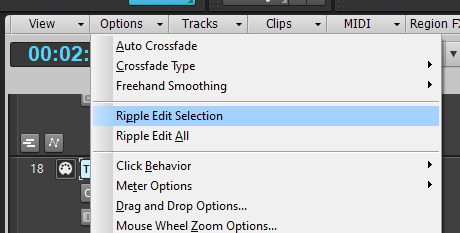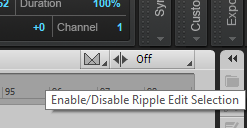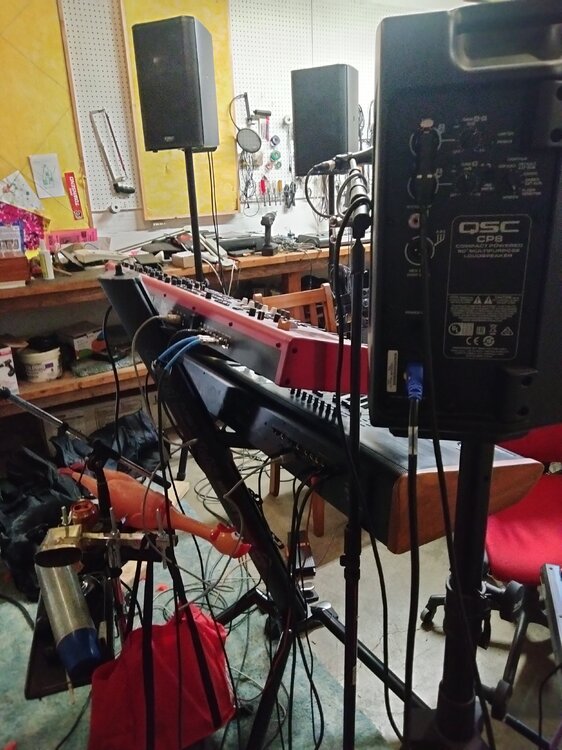-
Posts
3,070 -
Joined
-
Last visited
-
Days Won
18
Everything posted by bitflipper
-

I am sooo curious what the Bakers are up to next... 🧐
bitflipper replied to GreenLight's topic in The Coffee House
Hate to be the bringer of bad news, but CW has been getting a lot of complaints from the EDM crowd and will be responding with a Cheesifier plugin. Apparently, bit-crushing, lo-fi-ing, robo-quantizing and extreme auto-yodeling aren't cheesy enough and occasionally a catchy melody slips through, upsetting the MDMA-addled ravers and shaking them out of their trance. -

Missing vst errors loading old project with Kontakt plugins
bitflipper replied to Sven's topic in Cakewalk by BandLab
You can find the paths to plugins - as Cakewalk understands them - by looking in the system registry. Open REGEDIT and press F3 to pull up the Find dialog. Search for Cakewalk Music Software. Under that key will be a subkey called Cakewalk VST x64, and within that another subkey named "Inventory". Lots of information in there, some of it obvious, some of it obscure, but worth an examination. That method works to locate registered plugins, meaning all plugins that were found and successfully initialized by the VST scanner. It won't help you find duplicate instances, though. I usually resolve that challenge with a global search, but I don't use the Windows Search feature because it's so slow and doesn't produce results I can refine my search within. Instead, I open a DOS window and run something like this (in this example, to find all FabFilter plugins): c: cd \ dir FabFilter*.dll /s > fabfilter.txt & notepad c:\fabfilter.txt This will create a file called fabfilter.txt that lists every DLL named "FabFilter[something]", and then open it in Notepad. To find every instance of Kontakt, just substitute "kontakt" for "fabfilter". -
But it takes at least ten minutes. 3-minute songs don't work unless you play them over and over. This fellow has probably given more thought to the subject than any of us, certainly more than I have. When I'm entertaining an audience, I worry that long songs might bore them. But maybe by pandering to the short attention span of the social media generation we're robbing them of a transcendental experience. I remember back in the 60's when the consistently most well-received song my band played was Inna-Gadda-da-Vida. It went on for so long that even I'd start to get bored with it. But there was something about the tempo and the repeating riff that put people into a hypnotic state. Granted, that state was also encouraged via chemical assistance, but I remember achieving that state of consciousness by listening to She's So Heavy, even without benefit of drugs. Let's bring back the ten-minute song!
-

Missing vst errors loading old project with Kontakt plugins
bitflipper replied to Sven's topic in Cakewalk by BandLab
Yes, you could do that but I wouldn't recommend it because you'll end up with multiple copies and the next time Kontakt is updated you'll be left wondering which of them actually got updated. That's what's great about symbolic links - you still have just one copy of the file, but now the O/S can get to it multiple ways. You create a symbolic link using the mklink command, which you run in a DOS window. This command creates a pseudo-folder that's actually a pointer to somewhere else. Let's say you have a project that references c:\VSTGone\VSTGone.dll, but either that DLL isn't there anymore or the whole folder is gone because it's been moved to the D: drive to free up space on your system drive. You can use mklink to create a fake c:\VSTGone folder, and tell it the real location. The mklink syntax is: mklink /d {new_folder} {old_folder} Let's say Kontakt was originally installed at C:\program files\Native Instruments\Kontakt but that folder's no longer there, and has since been moved to D:\Kontakt. In this case, you'd use mklink to create a dummy folder that points to the actual location: c: cd \program files\Native Instruments mklink /d D:\Kontakt Kontakt Now you have a pseudo-folder named c:\program files\Native Instruments\Kontakt. Any program that references it will be automatically redirected to D:\Kontakt. This happens at the file system level, so Cakewalk need not know of this sleight-of-hand and existing projects need not be modified. -

Missing vst errors loading old project with Kontakt plugins
bitflipper replied to Sven's topic in Cakewalk by BandLab
The best solution I can think of would be to recreate the original paths using symbolic links. This, however, requires that you know the original locations of the Kontakt executables, and possibly also the original locations of the libraries if they've also been moved. The beauty of symbolic links is you can move programs and data to a new file location without the DAW or VSTs knowing you've done it. They continue to look in the previous place and the Windows file system quietly redirects them to the new folder. But again, this fix does require that you first know the old pathnames. -
Don't try pitch-shifting stereo tracks. Don't try it on guitars that are heavily effected. It won't work well on anything that has a lot of unpitched content, such as tuned percussion. Clean mono tracks only. Make sure you're not over-thinking it. If the vocalist struggles to hit a few high notes, for instance, it would be a lot easier to pitch-shift just those problematic notes on the vocal.
-
If you're a) Canadian and b) a Rush fan, Beyond the Lighted Stage is a must-see. I was neither when I saw it, and came away still not Canadian but definitely a fan. Another rockumentary that changed my view of a band was Rammstein in Amerika , about the East German band Rammstein. That particular genre normally ain't my cup o' tea, but the film made me respect those guys a lot. Anvil! The Story of Anvil. About a band that almost made it. They should have. Most of their contemporaries made it, and their style was popular at the time. But things didn't break their way. It has a happy ending, though. One of the most emotionally impactful films was Heavy Metal in Baghdad, about a band's struggles to survive in a country that morally despises their style, while a war is going on. Then there's Gimme Shelter, which covers the disastrous Rolling Stones concert at Altamont. I saw that at a drive-in while high. It was upsetting. Should be a more comfortable watch in the safety and comfort of your own living room. Here's a list from imdb that I found while trying to remember the name of the Rammstein doc.
-
Yeh. What I'm saying is don't worry about the overall levels while mixing, as long as they're reasonable (e.g. peaking at -12 dB). If it sounds too quiet, turn up your monitors to hear what it ideally should sound like at commercial levels. If you subsequently master with a gentle hand, it'll retain much of the punch and dynamics in the pre-mastered mix. If it still sounds weak with the limiter, disable it and revisit the tracks, which may be in need of additional compression to make them sound fuller. This, btw, is not universal advice. Many insert a limiter early in the process so that they can hear its effect on the mix in progress. I prefer to hold off on that step until late in the mix process. If the mix doesn't stand on its own pre-master, then it's not ready for mastering.
-
For a long time that was standard practice, and for good reasons. With digital audio, however, gain-staging becomes less important. (Not unimportant, but less important). There is really no benefit to maximizing individual tracks, not like when we were battling noise in the analog domain. In a DAW It's perfectly OK to have your tracks peaking at -12 dB or lower. It preempts other potential problems down the chain. And yes, if you need to turn the vocals down you'll likely also have to turn instruments down by the same amount. That's OK, even if the signal going into the master bus seems low, even if you have to turn up your monitors. Don't worry about the full mix volume while you're mixing. Wait until the mix sounds good, then as a final step use a limiter to bring the overall volume up to your final target levels.
-
Short answer: turn everything down. You're right, the doubler is effectively adding two more tracks, which are summing with the main vocal. And because they are essentially copies of the main vocal, they're going to experience constructive interference, meaning a bigger jump in peak values than you might expect. You probably won't hear any distortion, because you're working with floating-point data and that means there's no clipping even when you go into the red. However, it doesn't mean distortion (specifically digital overs, the nastiest-sounding kind of distortion) won't haunt you later because the real world isn't floating-point. This is even more likely if you end up exporting to MP3. Just pull back all the vocal tracks to give yourself 8-12 dB of headroom. Easiest way to do that is to group them and use the Gain slider. If you have compression on the vocal tracks, you'll have to go back and tweak the threshold setting, lowering it by the same amount.
-
Paul is totally legit. Look, he knows Hans Zimmer personally! Even brought him a Coke and seems pretty pleased about it. Meanwhile, Hans is busy explaining to the other guy that it's not his fault, Tina Guo just doesn't date nerds. The fellow wearing glasses with another pair hanging from his shirt didn't even have to ask.
-

Bass jumps out of tune randomly
bitflipper replied to David Pollock's topic in Instruments & Effects
It doesn't have anything to do with it being bass specifically. Easy workaround for the time being would be to just change the input MIDI channel on that track to something other than what your controller's set to (probably channel 1). -

Bass jumps out of tune randomly
bitflipper replied to David Pollock's topic in Instruments & Effects
Try to determine whether the symptom is random, intermittent, or both. "Random" implies that the detuning occurs in various different places along the timeline, without consistency. If it's intermittent but not random, that means it occurs at the same place(s) but not all the time. If truly random, hardware would be a prime suspect. A bad potentiometer on a cheap scroll wheel (iow what most of us are using) can generate spurious events just by rolling your chair nearby. If you hear the pitch shift while the controller's disconnected, then you can be certain that's not it. You could also try selecting a different MIDI channel (anything but channel 1) for the bass track. That would effectively disconnect the controller. By default, new MIDI tracks are set to Omni, meaning they respond to any and all incoming MIDI commands. -

PA Flash Sale: Noveltech Character & Vocal Enhancer each $14.99
bitflipper replied to Frank's topic in Deals
Two different animals. Nectar is a multi-fx unit, the others are one-trick ponies. The only similarity is that both have distortion, although Noveltech plugins are mostly just distortion. -

PA Flash Sale: Noveltech Character & Vocal Enhancer each $14.99
bitflipper replied to Frank's topic in Deals
I have achieved good results with Vocal Enhancer, but it's a dangerous weapon. Used conservatively, it can brighten a dull-sounding vocal and make lyrics more intelligible. But it's also extremely easy to turn a track into an ice pick to the ears. Worth the 15 bucks? Yes, it is. Just don't go nuts with it, and when you apply it make sure to re-listen to the mix the next day and see if you still think it's helping. -
Exactly. And it is a bug, I think, because you can lasso other things and drag the rectangle beyond the visible region, such as MIDI notes in the PRV or clips on a track. It's likely that it's always worked this way. I've never noticed because I always zoom out before selecting a group of things, to make sure I know exactly what I'm selecting. I'd rather accidentally exclude a node than to unintentionally include one I didn't intend to move.
-
Confirmed. The thread title threw me off at first. It says the nodes are un-selected if scrolled out of the viewing area, but that's a misleading description. I tried every method of scrolling I could think of: up/down, left/right, using arrow keys, Home/End, Ctl-Shift-PgUp/Ctl-Shift-PgDn, scroll wheel and horizontal/vertical scroll bars. Tested on both audio and MIDI tracks. All worked as expected. The only way to duplicate the problem, is to do it exactly like Olaf demonstrates it in the top post. The issue isn't nodes scrolling out of view in general, but rather when the view scrolls horizontally to accommodate a wide selection rectangle that won't fit into the viewable region.
-
Once played with a drummer who used the stage name Buck Futz. I borrowed that name when I needed to populate a test database. My business partner then adapted the test database as a demo database and started using it for product demos at trade shows. We lost a potential sale when a show attendee spotted it on a report and said we she couldn't take us seriously with such a sick sense of humor. I told him that customer would have been trouble anyway.
-
Can be toggled via a button in the upper-right corner of the track view window. Button changes color when ripple edit is enabled.
-
Nobody touches her "giant c***k" - her name for it, not mine. Last rehearsal our bass player requested she not use such crude nomenclature on stage, a request that was duly noted with all the respect you'd expect in a democratic enterprise - and then subsequently mocked ruthlessly for the rest of the day. Fortunately, "c***k-hater" did not stick as his new nickname. Poor Steve, he's the new guy. But he's gradually learning that she not only takes pride in her Janis Joplin, she literally channels Ms. Joplin, Southern Comfort and all. We've been playing out pretty regularly since December. Turns out, there are plenty of gigs and a mysterious shortage of bands to play them. At this point, 3 of the 6 of us have had COVID. I have avoided it mainly by being an antisocial curmudgeon. I knew it would pay off someday.
-
The new keyboard stand arrived yesterday. It's nice. Very stable. As I expected considering its price. Here's the new rig, in my cluttered garage / rehearsal space. Yes, that's a plastic chicken in the image. Our singer didn't want to be limited to tambourine and cowbell.
-
Incredible arrangement. Dolly is such a treasure.
-
That would actually be a cool enhancement, to open a default project just for editing MIDI. It would not be easy to implement, though, since a MIDI file can contain multiple tracks/instruments. From a practical standpoint, it makes more sense to click on the cwp file and open the project. I'd be uncomfortable editing one MIDI track in isolation without being able to hear it in context.
-

Strange horizontal line appearing in Cakewalk?
bitflipper replied to jono grant's topic in Cakewalk by BandLab
Those kinds of artifacts aren't uncommon. I've even seen them in my own software over the years. It always came down to the video adapter (and/or its driver). I used to see them on my system years ago, but they went away when I upgraded my graphics card. Often those artifacts will disappear when the screen is redrawn, such as when restoring the main window after being minimized. -

Updating plugins makes them non-functional in older projects
bitflipper replied to Bobo Fret's topic in Cakewalk by BandLab
+100! Recommended reading for beginners and old hands alike.









